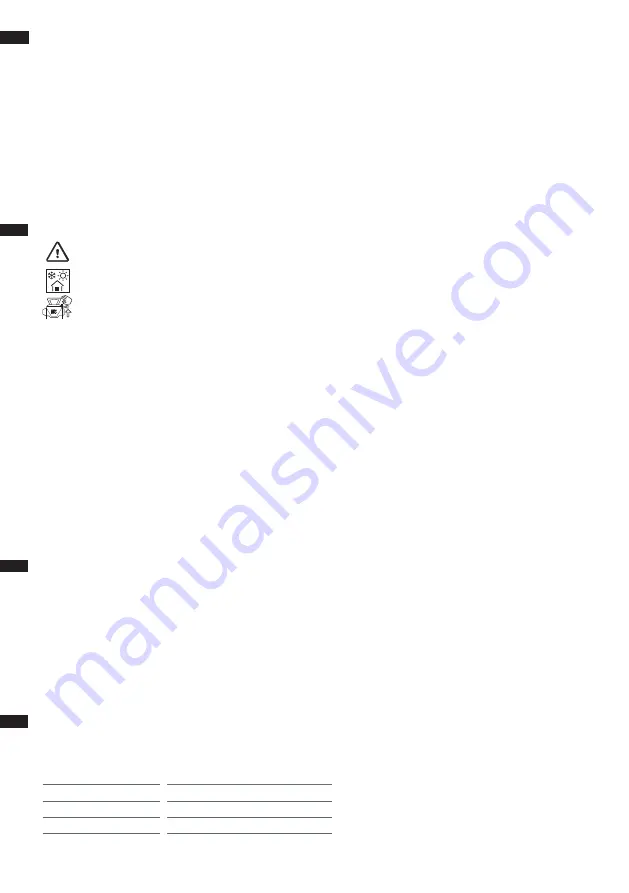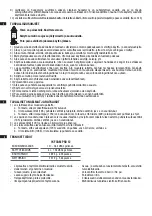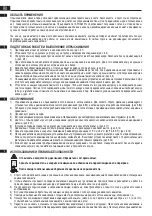
MAINTENANCE
1) After each use, depressurise the sprayer. To facilitate the total depressurisation, place the valve in the position of
automatic depressurisation (Figure 3.8b). Then, return it to its working position. (Figure 3.8a)
2) Collect and dispose of the residual amount according to the legislation, prescriptions, and applicable regulations.
3) Clean the appliance with water.
4) In the event of obstruction of the nozzle, clean it with water and do not use metallic objects. (Figure 3.9)
5) In order to prolong the life of the joints, regularly apply some drops of oil or grease on the moving parts. (Figure 3.10)
6) Obstruction of the handle. Release the handle and clean the fi lter. (Figure 3.11)
7) To replace the retainer, loosen the screws of the chamber and remove the rod (Figure 3.12)
8) Store the sprayer indoors protected from frost and extreme heat (between 5ºC and 30ºC (40ºF & 85ºF)). (Figure 3.13)
9) The apparatus has a felt pad installed in front of the nozzle. This fi lter is to be cleaned with water when it is dirty.
If it is completely damaged or is extremely dirty, replace it with a spare part. In the device there is a strip with 10
supplementary fi lters. Remove the used fi lter using a pointed object. (Figure 3.14)
10) If the apparatus does not spray or appears to be clogged loosen the hose of the tank, loosen the connection stub and
remove the suction hose and clean with water.
USES AND SAFETY REGULATIONS
This is a pressurised vessel. Handle with care.
Store the sprayer indoors protected from frost and extreme heat.
After each use, depressurise the sprayer.
1) Always follow the instructions and dosages on the packaging labels, that the manufacturer recommends for the chemical
product to be used.
2) To avoid any consumption of the product, do not eat, drink or smoke while preparing and spraying.
3) Do not spray on people, animals, electrical installations, fl ames, open fi re, or other sources of ignition.
4) In case of poisoning, consult your doctor, taking the chemical product packaging with you.
5) Never dispose of waste product or cleaning residues near water courses, wells, etc.
6) Use suitable safety equipment, mask, goggles, gloves, footwear etc in order to avoid contact of chemical products with
skin, eyes and mouth.
7) Read the instructions for the sprayer before its use. Do not modify the sprayer. Do not obstruct or strike the safety valve.
Do not use the sprayer if it is damaged, deformed or altered from its original shape. Should the hose, tank, handle or any
of its connections be damaged, do not attempt to repair but replace the items with new parts.
8) Keep sprayer out of reach of children.
9) Use the device only with compatible substances (Scope of Application).
10) The safety valve should not be removed.
11) Never purge nozzles or valves by blowing with your mouth.
12) Use only spare parts and accessories from the manufacturer.
13) We will not be held liable for any damage caused by the use of foreign parts.
14) Depressurise the tank completely before fi lling, after use and before carrying out work relating to maintenance.
15) Once the spraying work is fi nished, lock the handle to avoid any involuntary operation.
COMMON PROBLEMS AND SOLUTIONS
1) If pressure does not build in the appliance:
a. Check to see if the retaining collar (613) is worn.
b. Remove the chamber valve (165), clean the valve itself and the support surface. If it is damaged, replace it.
c. Check that the infl ator (1254) is properly attached. Check that the joint (609) and the support area are clean and
unmarked.
2) If, once pressurised, the rod rises on its own and/or liquid comes out through the chamber, clean the chamber valve (165)
and the support surface. If it is damaged, replace it.
3) If the safety valve (1291) does not pop out, apply oil/grease and trigger it.
4) If the appliance appears to be blocked and/or does not give out suffi cient product:
a. Check that the felt in the nozzle (1233) is clean. If not, change it.
b. Release the coupling (1288), remove the suction tube and clean it with water.
TECHNICAL SPECIFICATIONS
TOTAL CAPACITY
USEFUL CAPACITY
GROSS WEIGHT
NET WEIGHT
10 l. - 2.64 U.S. Gallons.
6 l. - 1.58 U.S. Gallons.
2.99 Kg - 6.59 lbs.
2.57 Kg - 5.66 lbs.
IK FOAM PRO 12
- Translucent tank with level indicator.
- Innovative and ergonomic design.
- Stable base with support for the feet.
- Large integrated funnel for easy fi lling.
4
5
6
3





































